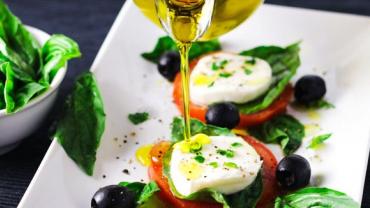
Some people say that a classic Caprese salad represents the colors of the Italian flag: there’s sliced mozzarella cheese for the white ripe tomatoes for the red and fresh basil leaves for the green. But this delicious summertime starter is more than just pleasing to the eye. The cheese is a good source of protein and healthy fat and the tomatoes bring vitamin C and the carotenoid lycopene. But what about the basil? Are those simple green leaves there just to look pretty and round out the plate? On the contrary basil delivers plenty of health benefits of its own.
Although we most commonly think of basil being a staple herb in Italian cuisine variations of the more than 160 known cultivars of basil are also widely employed in Southeast Asian cooking usually as Thai basil. Basil is believed to have originated in India and with tomatoes having been a New World food it’s interesting that two of the most recognizable ingredients in Italian dishes weren’t even native to Italy.
It’s unusual to consume large amounts of basil in one sitting but a good pesto sauce can certainly deliver a concentrated dose. And there’s nothing wrong with that since just one ounce of fresh basil packs 145% of the daily value (DV) for vitamin K 30% of the DV for vitamin A (as carotenes) and also delivers appreciable amounts of folate manganese iron and calcium.
One of the most widely studied aspects of basil is its essential oil. You’ve probably smelled this pleasant aroma if you’ve ever rubbed a fresh basil leaf between two fingers and then inhaled. You might have even noticed a mild calm or sense of well-being come over you even if just fleetingly after smelling it. Basil oil is believed to reduce mental fatigue and may have slight mood-boosting properties.
Basil does more than preserve good spirits. Food scientists think the herb’s antimicrobial antifungal and antioxidant properties could make it a safe natural food preservative helping to protect against food-borne pathogens and preserve the stability of foods that contain unsaturated fats which are susceptible to oxidation and rancidity. As an antifungal basil oil has shown efficacy against Candida albicans overgrowth of which is responsible for many common yeast infections and oral thrush.
Another of basil’s hidden talents might be in helping to support healthy blood sugar levels. Studies in rats have shown that basil extract mildly inhibits some of the enzymes that break down carbohydrates into glucose. This would ultimately release less glucose into the bloodstream or release it more slowly which may help moderate the glycemic response after a meal. While this might offer a small bit of help for blood sugar management let’s not mince words: it’s definitely not license to spread pesto over a large bowl of pasta or dip lots of bread in it. Keep the basil ditch the dense starches. Pesto works equally well over chicken fish and steamed or roasted vegetables.
Basil starter plants are common sights at summer farmers’ markets but basil can be grown year-round in a warm sunny spot. In fact basil usually grows so quickly if you’re not careful you could start with a little plant and end up with a small jungle. But considering the benefits of basil—plus its great taste—that could be a good thing.
As for using basil in your kitchen here are some wonderful ways to use more of this aromatic herb:
Sources: